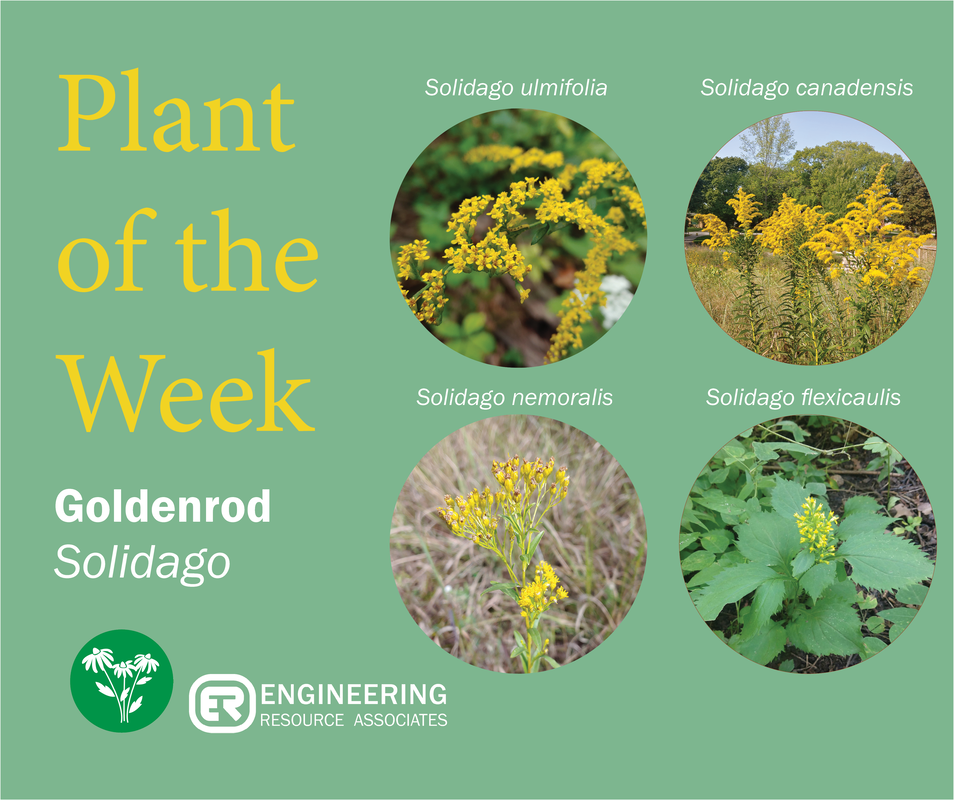This week we celebrate the colors of fall by shining a spotlight on the ubiquitous Solidago!
The genus Solidago, also known as goldenrods, is a very common and important plant found throughout the tallgrass prairies and savannas of Illinois. These generally stout, tall plants exhibit yellow blooms of varying size and shape and bloom through the fall and summer and are a staple source of food for pollinators seeking pollen or nectar or grazing animals who may feed on the foliage. Goldenrod can also provide habitat for insects over winter who may seek shelter in the hollow stems or stem galls (a benign growth on the exterior surface of a plant that can be used to house insect larvae).
Goldenrod as a genus consists of some 120 species in the aster family spread across North America and are found in varying types of habitats from open wetlands to dry forests. Some goldenrods appear very similar (S. canadensis and S. altissima) while others have drastically varied features, making for a quick ID (S. flexicaulis and S. ulmifolia).
Of significant note, is the common misconception that goldenrod, as the primary bloomer on the fall prairie, is somehow responsible for hay fever or other severe allergy issues. This could not be farther from the truth. Because goldenrod is insect pollinated and not wind pollinated, the pollen grains are too heavy to be wind-blown and are not a common cause of allergic reactions. Ragweed, on the other hand, contains up to a billion small, wind-blown pollen grains that can stay airborne for days at a time and are responsible for about half of all pollen-related allergy cases in the United States (primarily annual ragweed [A. artemisiifolia] and giant ragweed [A. trifida], the latter of which can reach heights of up to 12’ tall).
So, if you see goldenrod blooming this fall, bust out your favorite wildflower guide and check around for some friendly pollinators working away to prepare for the winter.
The genus Solidago, also known as goldenrods, is a very common and important plant found throughout the tallgrass prairies and savannas of Illinois. These generally stout, tall plants exhibit yellow blooms of varying size and shape and bloom through the fall and summer and are a staple source of food for pollinators seeking pollen or nectar or grazing animals who may feed on the foliage. Goldenrod can also provide habitat for insects over winter who may seek shelter in the hollow stems or stem galls (a benign growth on the exterior surface of a plant that can be used to house insect larvae).
Goldenrod as a genus consists of some 120 species in the aster family spread across North America and are found in varying types of habitats from open wetlands to dry forests. Some goldenrods appear very similar (S. canadensis and S. altissima) while others have drastically varied features, making for a quick ID (S. flexicaulis and S. ulmifolia).
Of significant note, is the common misconception that goldenrod, as the primary bloomer on the fall prairie, is somehow responsible for hay fever or other severe allergy issues. This could not be farther from the truth. Because goldenrod is insect pollinated and not wind pollinated, the pollen grains are too heavy to be wind-blown and are not a common cause of allergic reactions. Ragweed, on the other hand, contains up to a billion small, wind-blown pollen grains that can stay airborne for days at a time and are responsible for about half of all pollen-related allergy cases in the United States (primarily annual ragweed [A. artemisiifolia] and giant ragweed [A. trifida], the latter of which can reach heights of up to 12’ tall).
So, if you see goldenrod blooming this fall, bust out your favorite wildflower guide and check around for some friendly pollinators working away to prepare for the winter.

